Simplified Myers Briggs Type Compatibility Chart
INFP ENFP INFJ ENFJ INTJ ENTJ INTP ENTP ISFP ESFP ISTP ESTP ISFJ ESFJ ISTJ ESTJ
INFP
ENFP
INFJ
ENFJ
INTJ
ENTJ
INTP
ENTP
ISFP
ESFP
ISTP
ESTP
ISFJ
ESFJ
ISTJ
ESTJ
Chart Legend

 Uh-Oh, Think This One Through
Uh-Oh, Think This One Through

 It Could Work, But Not Ideal
It Could Work, But Not Ideal

 One Sided Match
One Sided Match

 It's Got a Good Chance
It's Got a Good Chance

 Often Listed as an Ideal Match
Often Listed as an Ideal Match
Notes: The compatibility above is based on relationship satisfaction surveys as well as type compatibility.
Keep in mind, by its very name, this is meant to be a simplified chart for quick reference. Every relationship is unique. A good match on this chart doesn't necessarily mean a good match in real life, nor does a bad match mean an otherwise healthy relationship is doomed.
Do not rely solely on this chart for making decisions on existing relationships, whether romantic or in the workplace. If you want to better understand a particular relationship, I strongly recommend reading deeper on each of the two types before jumping to any conclusion.





 It Could Work, But Not Ideal
It Could Work, But Not Ideal
 One Sided Match
One Sided Match
 It's Got a Good Chance
It's Got a Good Chance
 Often Listed as an Ideal Match
Often Listed as an Ideal Match